When its ratings dipped, attendance faltered and sponsorships shrank after the recession, NASCAR regrouped. The sport’s sanctioning body crafted a five-year plan designed to improve its communications, upgrade its facilities, sharpen its digital media operations and diversify its fan base by attracting young and multicultural fans.
This year marks the second year of that plan and NASCAR already is seeing early returns. It has opened a fan engagement center to bolster its communications, launched a new NASCAR.com, aired its first race on Spanish-language TV and completed six new ads targeting younger fans.
As the sport opens another season and begins the second year of its strategic plan, we decided to look at the people behind several of those efforts. They are at the forefront of change in the sport, charting a new path and driving the sport forward. They are faces of the future, and they are taking bold steps to reinvent NASCAR’s business.
Terry Finley
Creative director / Ogilvy Group
When Ogilvy Group’s Terry Finley attended the NASCAR Sprint Cup race at Chicagoland Speedway late last year, he was given a premium, behind-the-scenes experience. He rode in the pace car, waved the green flag, sat on pit boxes and lounged in team haulers. The whole experience brought back memories of his childhood.
Finley, who is spearheading Ogilvy’s work on a new brand campaign for NASCAR, grew up outside St. Louis in a small
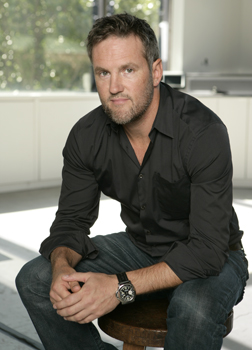 |
| Photo by: Ogilvy Group |
town with a dirt track where his older brother drove a 1955 Chevrolet Chevelle. But until the trip to Chicagoland, the 46-year-old hadn’t been to a race or followed motorsports since he was 15.
“It reignited things inside of me that have been laying dormant,” said Finley, who characterized himself as a lapsed motorsports fan who watched little more than the Daytona 500 every year. “I’m kind of perfect for this job. They need to get new people.”
NASCAR tasked Finley and Ogilvy with that challenge last year when it turned responsibility for its brand image over to the agency. It wants Ogilvy to develop a campaign that showcases the sport’s edginess and attracts not only new fans, but young new fans.
Finley plans to do that with a campaign that erases misperceptions about NASCAR — that it’s a boring sport focused on cars going around in circles — and highlighting the fun, competitive and wild things that happen at the track to make the sport great.
“I think it got a little corporate,” Finley said of NASCAR’s brand. “This is an edgy-authentic-crazy-heroes-from-an-outlaw brand. You have to serve that back with a younger lens.”
Ogilvy has developed six TV ads and the first spot will debut during the Daytona 500 this weekend. Finley says the backbone of the campaign is NASCAR’s drivers, and said the visuals, language and music all skew younger.
“It’s not Justin Bieber or video games,” he said. “It’s in the millennial sweet spot. Good times. Crazy, exciting fun. It is going to be really amazing stuff.”
Bryan Cook
Digital marketing manager / Joe Gibbs Racing
When Bryan Cook joined Joe Gibbs Racing as the team’s first digital hire in 2009, the team was outsourcing its website and frustrated that traffic was lower on race days than any other day of the week.
“It didn’t make sense,” Cook said. “We had all this content and insight and a story to tell, and fans were going elsewhere for it.”
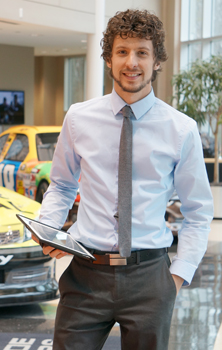 |
| Photo by: Joe Gibbs Racing |
Cook, 27, spent the last three years changing that and put the team at the forefront of digital innovations in NASCAR. He developed the sport’s first team app in 2010, designed and built a mobile and tablet game called “Pit Crew Combine,” and pushed the team to the forefront of social media by injecting his personality into the team’s Twitter and Instagram accounts.
“JGR sets itself apart from the rest of the industry by the amount of quality content they are pushing out about the team and its drivers and the social media platforms it uses to consistently engage its fans,” said Ramsey Poston, whose communications agency, Tuckahoe Strategies, ranked Joe Gibbs Racing first among NASCAR teams in a recent study of digital and social media engagement. “The team also does a very good job integrating its partners into the site without clobbering visitors with hard sales pitches for merchandise. I think that’s the more effective approach.”
Cook grew up as a NASCAR fan in Miami and was so obsessed with it that he went to the University of North Carolina at Charlotte so that he could be closer to the sport. After graduating with a degree in art, he landed at Joe Gibbs Racing, which was bringing its digital operations in-house.
That move has been important to the team as it’s looked to offer sponsors more than logo space on the hood of a car. It’s a challenge all teams face, and Cook has tackled it by using digital and social media tools to provide sponsors with additional value.
For example, he introduced the paint scheme for The Home Depot’s tool brand, Husky, on Facebook and he tripled the number of fans the tool company had online.
“The top thing a sponsor wants is engaging more with customers,” Cook said. “Social media gives us a one-on-one interaction with fans that can snowball into positive branding for our partners.”
Daniel Honeycutt
Director, vehicle engineering / NASCAR Research and Development Center
The most important day of this year’s NASCAR season happened during the summer of 2012 at a wind tunnel in Mooresville, N.C., just outside Charlotte.
It was there that the sport’s three manufacturers — Chevrolet, Ford and Toyota — showed up to test their new Gen 6 cars and see if they complied with NASCAR’s specifications for downforce, drag and sideforce.
Daniel Honeycutt, director of vehicle engineering at NASCAR’s Research and Development Center, watched nervously
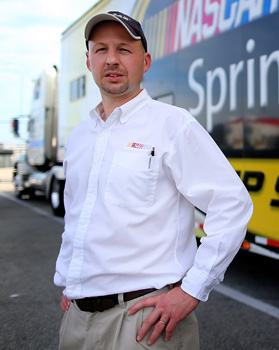 |
| Photo by: NASCAR |
from the wind tunnel’s control room. All three cars passed, and that set the stage for the debut of the new Gen 6 cars at this year’s Daytona 500.
It was a huge moment for Honeycutt, who grew up in Columbus, Miss., a short drive from a quarter-mile dirt track, and followed NASCAR his whole life. He earned a degree in mechanical engineering at Mississippi State and joined NASCAR when it opened the R&D center in 2001.
Three years ago, NASCAR named him one of the chief engineers working to create its new cars. The sport wanted cars that resembled the vehicles on a showroom floor. It hoped the cars could boost car sales and recreate the manufacturer rivalries that once captivated fans. That meant the cars had to look different but behave similarly so that no manufacturer had an edge in races.
It was Honeycutt’s job to ensure that equality. He and his team of six employees set specifications, spoke constantly with manufacturers, developed inspection devices, conducted more than 1,000 hours of wind tunnel testing, and listened to drivers’ impressions of the new cars.
The results of their work will be on display this weekend, and no one is more excited about that than Honeycutt.
“As a kid growing up watching the sport, I was used to watching cars that looked like they were on the showroom floor,” he said. “I’m glad to be a part of the team that brought that back.”
Darrell Wallace Jr.
Kyle Larson
Developmental drivers
Up-and-coming drivers Darrell Wallace Jr. and Kyle Larson don’t get hung up on their ethnicity, but ask them what they see when they look in the stands or walk through the pits and they’re honest.
“You go to the races and don’t see too many Asians,” said Kyle Larson, who is Japanese-American. “It would be cool to see different types of people at the racetrack.”
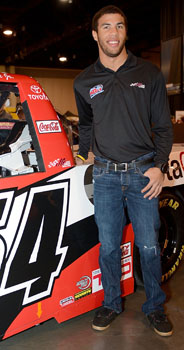 |
Darrell Wallace Jr.
Photo by: Getty Images |
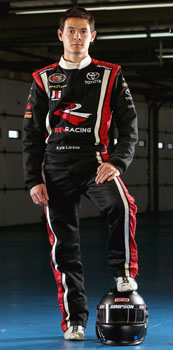 |
Kyle Larson
Photo by: Getty Images |
They both recognize they have a chance to change that.
“It’s been a predominantly white sport,” said Wallace, who is African-American. “It’s my job to change that. That’s what the diversity program [NASCAR developed] is all about. It’s about a new face, a new demographic, getting guys on the pit crew, in the stands and on the track.”
Wallace and Larson are the two most successful products of NASCAR’s diversity program, which it began in 2004 in hopes of developing minority and female drivers. Wallace this year will race full time in the Camping World Truck Series with Kyle Busch Motorsports. Larson, who is a developmental driver for Earnhardt Ganassi Racing, will race a full-time Nationwide Series schedule with Turner Scott Motorsports.
NASCAR hopes that they find success on the track. The sport wants to diversify its fan base and attract more Hispanic, African-American and other ethnic fans, especially as the size of the minority population in the U.S. swells in the coming years. It also wants to attract more young fans, a generation that’s accustomed to diversity in all areas of sports and life.
Wallace and Larson can help them with both.
— Tripp Mickle
Jim Renne
Principal / Rossetti
NASCAR track owners are studying new ways to improve the fan experience by moving sponsor-driven activities inside their venues, developing more premium seat options, and shrinking capacity for some events.
Those three components are among the initiatives that sports architecture firm Rossetti has focused on over the past four years at Daytona International Speedway, with the track serving as motorsports’ benchmark for change, said Jim Renne, a principal with the Detroit firm.
Rossetti, a designer of arenas and stadiums in the NFL, NBA, NHL and Major League Soccer, has developed a master
 |
| Photo by: Rossetti |
plan for improvements at Daytona, a track that opened in 1959.
Basically, Rossetti has flipped the traditional NASCAR model upside down by relocating merchandising displays and corporate hospitality inside the venue to keep the attention of younger race fans while creating unique experiences for high-end patrons. The goal is to get spectators flowing through the gates earlier with enough attractions on expanded concourses to keep them occupied.
“We are acknowledging a younger generation that’s much less patient and does not want to sit on its butt for four hours straight,” he said. “They want to wander, and right now at most of the tracks there’s nothing to wander to. They either go back out of the venue and maybe go to the retail merchandising areas or they leave. … We’re providing different ways to create more interaction, [and] to acknowledge technology in a whole new way that is current.”
Turning the revenue model upside down applies to premium seats as well. At most arenas and stadiums, the most lucrative suites and club seats are midlevel and event level. In NASCAR, the opposite is true, with the best seats for watching the race up high in the bowl, Renne said.
The sports architect also is coming up with a system at Daytona to temporarily reduce the 167,000 seats for racing events that draw smaller crowds. The challenge is to develop an affordable solution that can be turned around quickly from an operational perspective.
“The Daytona 500 is really the only time they fill the stands,” Renne said.
Brandon Igdalsky
President and CEO / Pocono Raceway
Brandon Igdalsky calls it Pocono 2.0. It’s his catchphrase for a period of modernization that Pocono Raceway has begun under the direction of its 35-year-old track president and CEO.
“We want to take Pocono from a 1974 facility to a 2015 facility,” Igdalsky said.
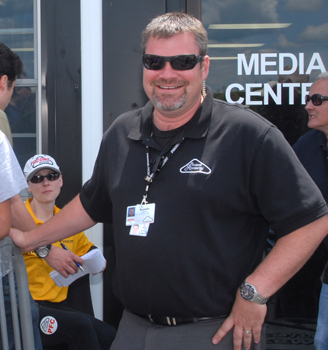 |
| Photo by: Pocono Raceway |
No one would welcome that vision more than NASCAR. The sanctioning body conducted a study two years ago that revealed that racetracks look antiquated and ordinary in the eyes of many fans accustomed to the amenities at modern pro sports facilities. It’s encouraged tracks to improve their facilities and the race-day experience.
Igdalsky began taking small steps over the last few years to do exactly that. The track installed a solar farm in 2010, and it became one of the first facilities in NASCAR to shorten its Sprint Cup race from 500 to 400 miles. Igdalsky said the decision was prompted in part because the race was consistently running four hours or longer. Taking 100 miles off of it, he thought, would allow fans to get home earlier.
Now, his priority is creating wireless hot spots to improve connectivity and installing video boards. Igdalsky believes both would go a long way toward improving the race-day experience and making a ticket to the race more compelling than the couch.
To help underwrite those improvements, Igdalsky is overhauling Pocono’s business model to pay for it all. Last year, he hired Front Row to sell sponsorships and race title sponsorships.
For all the changes, Igdalsky, who is the grandson of the track’s late owner, Dr. Joseph Mattioli, remains old school at heart. He learned Pocono’s business from the ground up, doing everything from picking up garbage and working on the sewage plant to selling tickets and hospitality.
His favorite thing is taking people to a race for the first time, and he looks forward to the day when he can walk into the track with longtime fans and show them an entirely different facility.
“In six or seven years, you’ll see a whole new Pocono,” Igdalsky said. “It will be a track everyone wants to be at.”
Jerry Steinberg
Senior vice president, field operations / Fox Sports
Camcat. Gyro-Cam. High-speed cameras. New virtual graphics. These are some of the new technologies Fox Sports plans to use during its Daytona 500 coverage this year, and guiding those efforts to take fans closer to the action is Fox’s Jerry Steinberg.
“I don’t know how many of these things will make air,” Steinberg said. “The great thing at Fox is working for people that encourage innovation and taking risks. We try a lot of different stuff. A lot of it works. Some of it doesn’t. Even
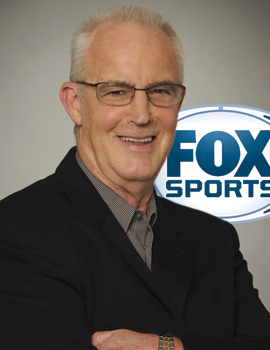 |
| Photo by: Fox Sports |
when we try stuff that doesn’t work, it doesn’t mean that we don’t keep trying.”
One innovation that is certain to make air is something Fox calls Camcat, which is a camera attached to a cable that can move several thousand feet at 85 miles per hour, giving viewers a faster look at the cars.
“We first saw it during Formula One,” Steinberg said. “We’re going to have it on the front stretch. It’s a unique look that nobody’s had before.”
Fox also hopes to debut something called a Gyro-Cam, an in-car camera that can pivot around to better illustrate how much the track tilts.
“One of the things that we’ve never been able to communicate to the viewer is the bank in the track, the severity of the angle,” Steinberg said. “With the Gyro-Cam, when the car hits the corner and the angle shifts dramatically, the camera will show that angle, or at least give you a sense for how it shifts.”
Steinberg, who has been in the production truck every time Fox has carried the Daytona 500, says the network uses the race as a way to try new things.
“If we had a general mission statement in all our sports, it’s to bring the viewer closer to the action,” he said. “It’s what [former Fox Sports Chairman] David Hill is fond of calling a unique visual difference.”
Colin Smith
Managing director, digital platform / NASCAR
On the day NASCAR planned to reveal its new website to the world, Colin Smith rolled through a series of disaster scenarios. He worried his digital team might move the site over and nothing would happen. No images would appear. No headlines. Only a blank screen.
“We had done so much testing that we thought it would work, but when you flip that switch and your site is getting called up by consumers, that’s when you’re relying on how you architectured the site,” Smith said. “Luckily, we had it work.”
 |
| Photo by: NASCAR |
That was good news for Smith. He joined NASCAR last year from Raycom Sports where he had spent 17 years doing everything from directing broadcast distribution to launching Raycom’s digital business. NASCAR, which reacquired its digital rights from Turner Sports, put Smith in charge of its multimillion-dollar effort to launch and manage its website and digital applications.
The site and apps are key tools in NASCAR’s efforts to attract younger fans, keep existing fans, raise the profile of its drivers and offer new assets to sponsors. Smith said his team hasn’t started analyzing Web traffic yet, so it doesn’t know if fans are spending more time at NASCAR.com, but the sanctioning body has benefited financially from taking over the site.
Mobil 1, which renewed as a NASCAR sponsor this year, said a key reason it did so was the opportunity to become the presenting sponsor of a feature on NASCAR.com called the Automotive Technology Center. It’s an asset that Mobil 1 would have previously had to buy separately.
The new NASCAR.com will get its biggest test this weekend when traffic is expected to surge during the Daytona 500. Smith will be overseeing a digital team 24-strong from the eighth floor of the sport’s office building in downtown Charlotte.
“Yes, we’ll be judged on what happens at Daytona, but we didn’t build this division for the 2013 Daytona 500,” Smith said. “This is a three-, five-, six-year project. We’ve done a ton of tests. We’re about as prepared as we can be.”
Sean Doherty
Director, digital and content communications / NASCAR
In a small, glass-enclosed room on the eighth floor of NASCAR’s Charlotte offices, images of line graphs, a NASCAR broadcast and NASCAR.com glowed from 13, 47-inch computer screens.
Sean Doherty stepped toward one of the screens and touched a spiky yellow line graph representing tweets about driver Jeff Gordon. The head of NASCAR’s new fan and media engagement center watched as the screen transformed into a list of tweets written moments after Gordon and Clint Bowyer brawled at last November’s Phoenix race.
 |
| Photo by: Enter NASCAR |
“We can load the tweets about any driver at any moment,” Doherty said, as he reviewed two dozen of the 24,000 comments made after that fight. “It’s that real rapid response system that will be very useful when the race is going on.”
It’s that type of instantaneous data collected by a new fan engagement center that NASCAR hopes will improve its ability to interact with fans, respond in moments of crisis, and provide detailed analysis to teams, broadcasters and sponsors that help them better understand the fan base.
NASCAR partnered with HP last year to develop the center, which uses HP software and computers to capture every tweet and Facebook post about the series. The facility is modeled after Gatorade’s Social Media Command Center.
Doherty was hired to run the center last year. He joined NASCAR from Sprint, where he worked on social media strategy and launched the company’s customer care Twitter program. He has hired four employees to work in the center, and their immediate focus is on communicating and tracking fans during race weekends, which they planned to start with the Sprint Unlimited race at Daytona last weekend. He expects them to spend this week analyzing the data they collect and preparing for the next race.
“We’re going to be learning a lot,” Doherty said. “It’s like an empty swimming pool we’re filling with data. As we get more data, we’ll have more context for what people are saying and what it means.”













